
Полная версия
The Wildlife-friendly Garden
Rolando Ugolini
The cultivated Prunus shrubs which make up this superb garden hedge are just as good for nesting birds as the wild shrubs.

GARDEN PROJECT – PLANTING A HEDGE FOR WILDLIFE
A hedge is best planted in the winter, and all the plants should be pruned to no more than about 30cm (12in) in height after planting them to encourage the growth of interlocking shoots. Don’t be too eager with your secateurs after that. A hedge does need to be trimmed from time to time, but if you want a really good wildlife hedge then you should do this only once every two years.
By doing this, you will always have some one-year-old wood on which many of the shrubs carry their flowers. It is a good plan to trim half the hedge one winter and the other half the next. Try to keep your hedge narrower at the top than at the bottom; otherwise the ground flora may become shaded out and some of the lower branches may die back and leave gaps.
Wildlife walls
Although, as a home for wildlife, a hedge beats a wall every time, there is still a place for a wall in a wildlife garden. This is particularly true on sloping ground, where small walls, no more than a metre (three feet) or so high, can be used to create a very attractive terraced effect.
You don’t need to be an expert bricklayer; in fact, you don’t really need bricks at all. You can try building a dry stone wall, using one of the many traditional styles that are found in upland Britain. Always use local stone if possible, as this fits into the landscape so much better than alien material. You may be able to buy large stones from a local quarry or a nearby garden centre. Failing this, get hold of The Natural Stone Directory (see here) which will tell you where you can buy almost every kind of stone.

CONSERVATION TIP
Never be tempted to buy water-worn limestone, often sold as Westmorland stone. It should not be for sale anyway, as it comes from one of our rarest habitats – the much-damaged limestone pavements of northern Britain – which are now protected by law.
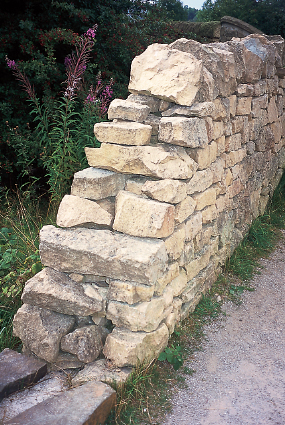
Michael Chinery
This section of a dry stone wall shows the large through stones which are used to tie the two faces of the wall together. The central cavity can be filled with soil or small stones.
A wildlife refuge
Because there is no mortar between the stones, except perhaps at the ends of the wall, the dry stone wall offers homes to a huge variety of animals: lizards bask and hunt on the wall by day, while toads hide in the cool recesses along with numerous spiders and beetles.
Bumblebees will also take up residence, and in the warmer parts of Europe they may be joined by the harmless little scorpion Euscorpius flavicaudis.
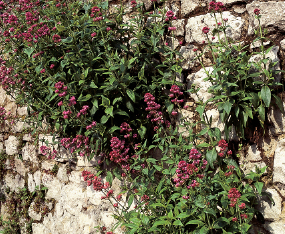
Michael Chinery
Red valerian is an attractive, although rather invasive, inhabitant of old walls. It attracts lots of butterflies and moths.
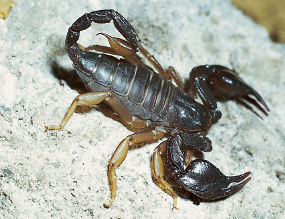
Michael Chinery
The scorpion Euscorpius flavicaudis inhabits old walls in southern Europe. You may see the pincers sticking out of a crevice.

Michael Chinery
The black redstart, uncommon in Britain but a common garden bird on the continent of Europe, regularly breeds in holes and crevices in old walls. Its nest is an untidy and none-too-secure pile of grass, which is lined with hair and feathers.
Wrens, black redstarts, great tits and pied wagtails are among the many birds that may find your wall to their liking.
The hedgehog is sure to find a snug retreat among the lower stones. And don’t forget yourself either: it is not difficult to incorporate a smooth stone slab in the wall so that you can sit comfortably and watch your garden guests.
Water your wall with a slurry of cow or horse dung after building it to encourage invasion by mosses and lichens, which then act as nurseries for ferns and other plants. It will soon become a home for wildlife.
GARDEN PROJECT – BUILDING A DRY STONE WALL
If your garden is flat, you can use low stone walls simply as decorative features or to create raised beds. Such beds are ideal for alpines and many other plants and, once built, they make gardening much easier as well! Old bricks can be used instead of stone, but you still do not need mortar. Dig out the wall base to a depth of one brick, making sure that it is fairly level and compacted down.
To retain a bed, the wall should be double thickness and no higher than four courses. Set each course of bricks on a mixture of sand and peat-free compost. Leave a few gaps between the bricks for lizards and other small creatures to get in, but otherwise the bricks in each course need to be in contact with each other.
You will not have to wait long for ferns and other plants to spring up naturally in the sand/compost mixture and bind the bricks firmly together, but you can speed things up by planting some yourself. You’ll find that houseleeks and stonecrops do very well on these walls. Remember that this wall is not for walking or climbing on!
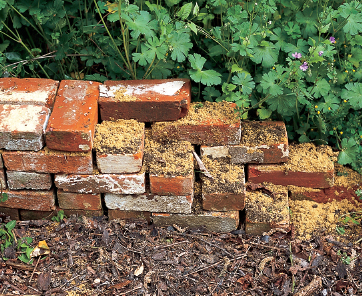
Rolando Ugolini
This very simple low wall is made of old bricks which are laid double thickness and across each other to bind and strengthen the wall. Leave some small gaps in between.
The garden pond
If you have room to create only one semi-natural habitat in your garden, then I think it should be a garden pond. This is one of the richest of all habitats in terms of wildlife. As well as providing homes for frogs, newts, dragonflies and many other exciting creatures, it provides food, drink and bathing facilities for birds and assorted mammals. And all will give you, the gardener, a great deal of fun.
If you are really lucky your garden might already have a stream that you can dam to make a small pond. Local rocks can be used to form the dam, or you can utilize a tree trunk. Oak and elm are good for this as both timbers survive well under water. A height of about 50cm (20in) is fine for the dam. Be sure to consult the appropriate authorities if you want to create a larger pool because anything more than a small dam could interfere with water supplies further downstream.
Most of us have to create our ponds from scratch, but this is not difficult if there are strong people to do the digging. Pond plants and animals like plenty of sunshine, so don’t site your pond under trees. Apart from creating a lot of shade, they will drop their leaves into the water in the autumn and cause a lot of problems. If you compare a woodland pool with one in the open, you will be in no doubt that the latter is a much richer and more attractive habitat.
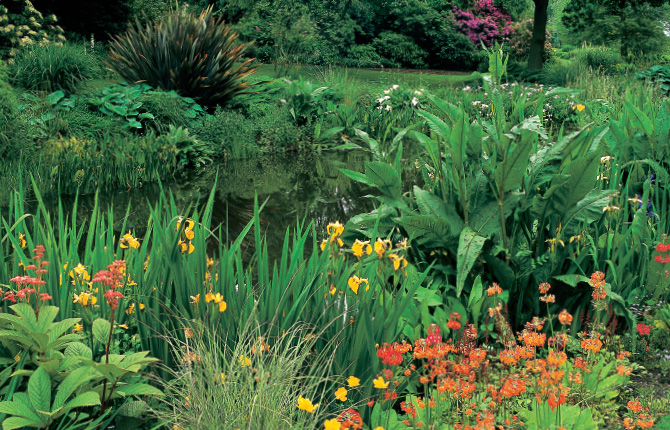
Acres Wild/Ian Smith
Surrounded by a rich variety of wild and cultivated marginal plants, including yellow irises and brilliant orange primulas, this pond will attract a wide range of insects and other wildlife, and there is enough open water to encourage frogs and dragonflies to come and lay their eggs.
Constructing the pond
Ponds dug in low-lying areas where the water table is close to the surface sometimes fill themselves, and you can’t ask for much more natural ponds than these. Otherwise you will have to line your pond.
Preformed fibreglass liner
If you decide on a preformed fibreglass liner, all you have to do is to buy one of the shape and size that you want, dig a similarly-shaped hole, and drop the liner into it (see). A morning’s work can give you a very attractive pond!
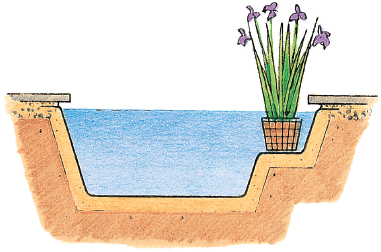
Acres Wild
Acres Wild/Ian Smith
This cross-section of a pre-formed fibreglass pond shows the correct level for a shelf for marginal plants. The surrounding paving stones must be firmly cemented into place and should overhang the edge sufficiently to conceal the edges of the pond liner. Frogs may shelter under these overhangs, but you need to provide one or more stepping stones so that the animals can get out of the pond.
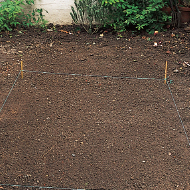
Acres Wild/Ian Smith
1 Mark the position of the pond with pegs and string or a line of sand for irregular shapes.
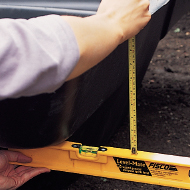
Acres Wild/Ian Smith
2 The excavation must match the profile of the unit. Measure all depths carefully from the rim.
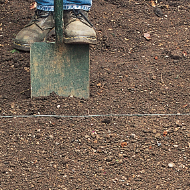
Acres Wild/Ian Smith
3 Allow for installation of the pool and back-filling by digging out a larger hole than marked.
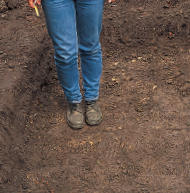
Acres Wild/Ian Smith
4 After removing all stones, make sure that the ground is compacted down.
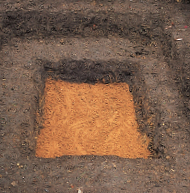
Acres Wild/Ian Smith
5 Smooth the sides and spread a 5cm (2in) protective layer of sand on the base and sides.
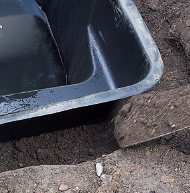
Acres Wild/Ian Smith
6 Press the unit gently until level, then part-fill with water and back-fill with sifted soil or sand.
Flexible liners
These liners allow you to have a pond of virtually any shape you like. You can use heavy-duty black polythene, but butyl rubber is a better material and, although considerably more expensive, it is likely to last much longer. Whatever you get, make sure it has at least a ten-year guarantee.
Calculating the liner size
You can calculate the required liner size by measuring the maximum length and breadth of the pond, adding twice the maximum depth to each dimension, and then adding a further 50cm (20in) to each to allow for sufficient overlap at the pond’s margins. Although you can choose whatever shape you like, butyl rubber liners are usually rectangular, so long, narrow ponds tend to be rather wasteful of this lining material.
WHICH WATER SOURCE?
The tap is usually the only source of water for the pond. The high mineral content of tap water may encourage the algae to multiply rapidly and turn the water green in the summer, but this will not harm the wildlife of the pond and the algae will gradually dwindle as they use up the minerals. The best thing, if you are planning to have a pond, is to store up a supply of rain water ready for filling it. Always use rain water to top up your pond in the summer: an adaptor fitted to a drainpipe can be used to divert water into a hose leading to the pond.
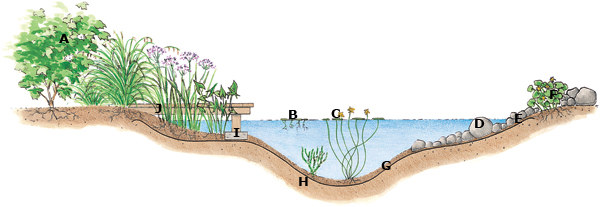
Acres Wild
A) Moisture-loving shrubs, such as guelder rose and alder buckthorn, can be planted around the pond, but do not let them shade the water
B) Free-floating plants, such as frogbit, provide shade for many small animals
C) The floating leaves of yellow water lily and similar plants make good landing pads for dragonflies
D) Large stones breaking the surface provide perches for drinking birds and basking spots for frogs
E) A sloping ‘beach’ makes it easy for animals to get in and out of the pond
F) Wetland plants, such as marsh marigold, provide food and shelter for insects and many other small creatures
G) The flexible liner can be covered with fine soil here and there to allow plants to root naturally
H) Submerged plants, such as curled pondweed and water milfoil, maintain oxygen levels
I) The jetty can be supported on building blocks, but these should be set on rubber or plastic pads to protect the liner
J) Native marginal plants, such as arrowhead and flowering rush, can be planted in the swampy area at the edge. They give a natural effect and provide cover for many animals
PROTECT YOUR LINER
Before installing the liner, remove any sharp stones that you can see and then line the hole with soft sand to protect the liner. You can also buy polyester matting specifically made for this purpose. Alternatively, you can use old plastic bags, as used for potting compost, but an old carpet is even better.
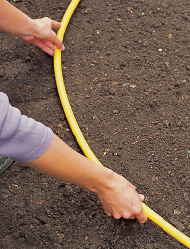
Acres Wild/Ian Smith
1 Decide on the shape and size of your pond and mark it out with a rope or a hose-pipe before you begin digging. Make the pond as big as you can, but ensure that you can get a liner of a suitable size before you start work!

Acres Wild/Ian Smith
2 Make sure that the edges of the pond are perfectly level, otherwise the liner will be exposed in some places. The central area should be at least 50cm (20in) deep to ensure that the whole pond does not freeze solid in a hard winter.
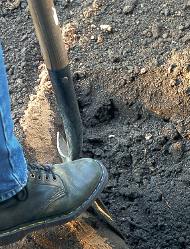
Acres Wild/Ian Smith
3 It is best to start digging in the centre and then slope the bottom gently up to the surface. Leave a flat shelf about 15cm (6in) below the final water surface on one side, so you can grow marginal plants there in pots (see here).
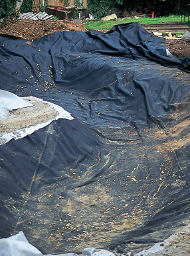
Acres Wild/Ian Smith
4 It’s now time to install the liner by spreading it over the hole and pushing it roughly into position. Weight the edges down with something heavy, ensuring that there is at least 25cm (10in) overlap all round the margin. Then you can start adding the water. As it runs in, the weight of the water stretches the liner and moulds it to the shape of the hole.
Конец ознакомительного фрагмента.
Текст предоставлен ООО «ЛитРес».
Прочитайте эту книгу целиком, купив полную легальную версию на ЛитРес.
Безопасно оплатить книгу можно банковской картой Visa, MasterCard, Maestro, со счета мобильного телефона, с платежного терминала, в салоне МТС или Связной, через PayPal, WebMoney, Яндекс.Деньги, QIWI Кошелек, бонусными картами или другим удобным Вам способом.







